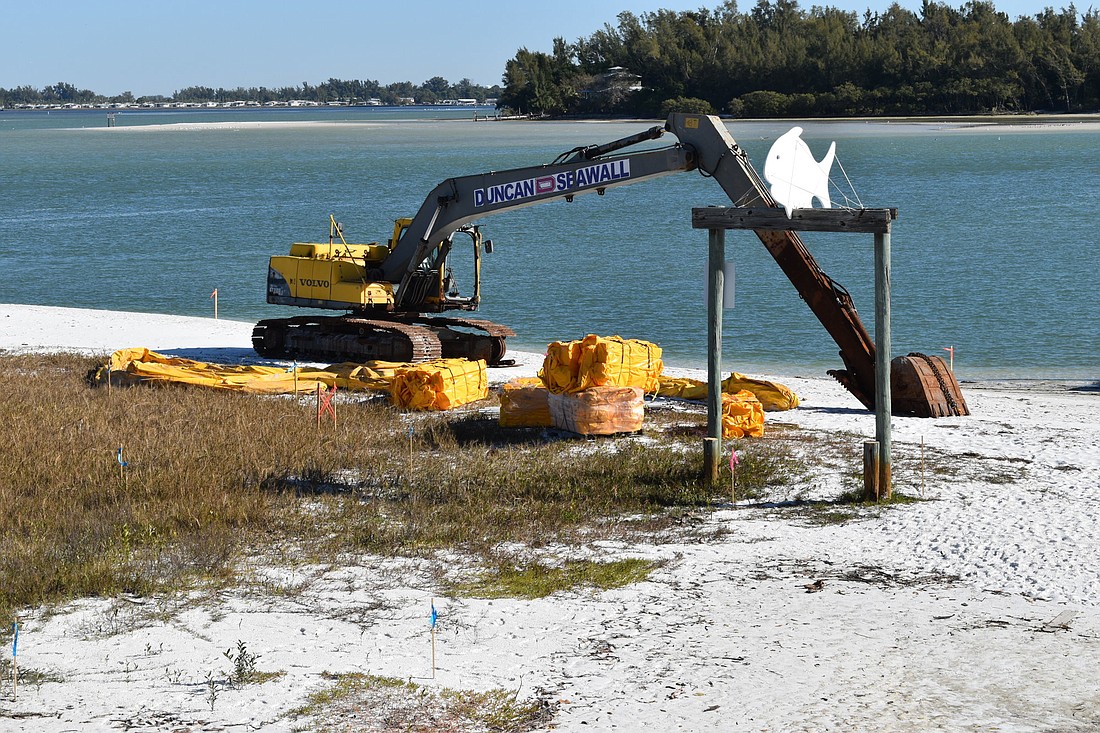- December 13, 2025
-
-
Loading

Loading

Boating and beach activities are closed east of the Longboat Pass Bridge on the north end of Longboat Key as work proceeds on an emergency dredging project on Canal 1A.
The town awarded the Canal 1A bid to Duncan Seawall Dock and Boat Lift, LLC for $81,755, according to Longboat Key town projects manager Charlie Mopps. Work began Jan. 25.
“[Duncan] had some equipment problems last week. Like they had a track that broke, so they’re bringing in a track, fixing it on the beach,” Mopps said. “They got it fixed.”
Mopps said he expects Duncan to finish the emergency dredging in about a week despite the equipment problems and gusty winds.
The area west of Longboat Pass Bridge remains open for beachgoers and boaters.
The canal project is designed to reopen passage to watercraft under the bridge and into the lagoon east of the gulfside beach. Shoaling over the last few years has rendered the canal virtually impassable for properties along North Shore Road.
While not directly connected to the town's comprehensive beach plan, borrowing for which voters approved in 2020, sand from the project will be used to further the beach work.
On Monday afternoon, Mopps presented to town commissioners about the town’s beach plans. They include:
A typical dump truck holds about 10-14 cubic yards.
Mopps said the town is due to save about $8.7 million in dredging and transport costs after awarding the beach work to Weeks Marine, Inc, which was the only firm to bid on the town’s beach projects. The town’s engineer initially estimated the project to cost $38,846,116.
While they didn’t place a bid, Mopps said Norfolk Dredging Co., Manson Construction Co. and Great Lakes Dredge and Dock considered bidding on Longboat Key’s beach projects.
“These are the giants in the industry,” Mopps said. “[They] were looking at this project.”
Longboat Key Mayor Ken Schneier asked Mopps why Weeks’ bid came in lower than the initial estimated cost, especially without a competing bid.
“This is just speculation because I’m not a contractor, but when you had Great Lakes and Weeks both looking at the project, and they’re like two of the biggest dogs in the dog park barking at each other, then it was a very competitive nature of this bid,” Mopps said.
Mopps said the majority of the savings comes in a cheaper cost for Weeks to haul sand from Passage Key. Instead of up to $60 per cubic yard for a truck haul, Mopps said it will cost about $33 on average per cubic yard of sand by using Weeks’ equipment for the project.
Weeks will also use Kelly Brothers as a rock subtractor for the groin work, and the town will pay Sea Turtle Trawling an additional $37,500.
Vice Mayor Mike Haycock asked what happens to the surplus of money if the project costs less than what the town budgeted.
“Depending on how much money is in the account, it could be used for different purposes,” Town Manager Tom Harmer said. “It could offset the next nourishment period. It could be used to pay down the existing bond. That’s up to the commission during the budget process.”
The savings comes after Manatee County commissioners voted in December 2020 to approve an agreement with Longboat Key for $2.69 million as part of the town’s beach renourishment project.
The county’s contribution is a part of Longboat Key’s multi-year plan worth between $42.5 million and $47.5 million to renourish 10 miles of gulf beaches. Beyond the cost of sand dredging and transport, there are other costs
In October 2020, Longboat Key town commissioners voted to authorize up to $22 million in bonds to finance several beach maintenance projects.
The town plans to pay off the bond debt between six and eight years.
Mopps said segment one on the north end of the island is the most pressing part of the beach renourishment project. The plan to build five permeable rock groins is expected to complement the two existing groins already in place.
Work on the Gulfside Road part of the project will borrow sand from Longboat Pass. The town plans this part of the work to start as soon as Manatee County’s Coquina Beach FEMA projects wrap up.
The Coquina Beach project is expected to dredge between 70,000 and 100,000 cubic yards of sand. The Gulfside Road project is expected to start in spring, and crews will dredge of what’s left of the initial 200,000 cubic yards of sand left at Longboat Pass. The town is still sorting out a contractor for this part of the project.
Regular dredging of Longboat Pass by the U.S. Army Corps of Engineers ended in 1998.
As for the New Pass groin maintenance and south-end nourishment, construction is set to start in winter 2022. It will tighten the groin and take about 120 days to finish.
“It should be a fairly short project, so we can do this entire project outside of shorebird and turtle nesting season,” Mopps said.
Mopps credited all the different parties involved in the massive beach project.
“The teamwork that it took to get to the point where we could actually do this really big project at this cost-saving, in the timeline that we’re doing and getting all the agencies and the consultants and the contractor together, and getting them to agree to allow this magnitude of a project to go on, when we’re doing it, is a major win on everybody’s part,” Mopps said.